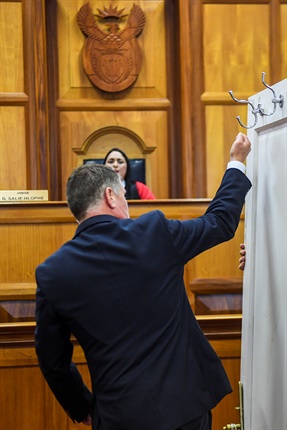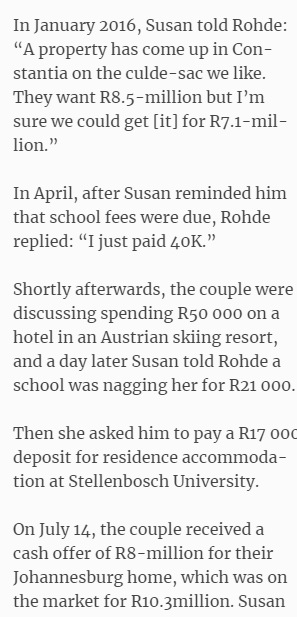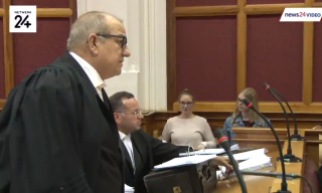It’s fascinating sitting in on the Van Breda trial, and then juxtaposing the court room strategies of that defence team with the Rohde trial. There are so many parallels to draw. These parallels show that there is a clear formula for defending these sorts of cases, and the formula is used because it works. Well, it has worked. It doesn’t always work.
In this blog I want to shed some light on the formula, enumerating some of these strategies and then dealing with them one by one. This is good stuff to know when one watches other court cases, and one can then see the wood for the trees, and see the overall game that is being played, rather than becoming bogged down in particular elements of a day’s testimony.

Just as the Van Breda case is basically indefensible, and yet the accused threw millions into his trial [R9 million apparently], the exact same circumstance applies here. Both defence teams have pleaded poverty at one point, and yet both have continued a long and hard fight going on for countless court days.
In my opinion, Jason Rohde’s so-called defence is just as absurd as Henri’s laughing pair of balaclava-clad intruders [who forgot to steal anything, forgot to leave any trace of themselves, and forgot to kill him]. But as absurd as Rohde’s defence is, it’s not that easy to dismiss in court, because there are some compelling reasons that show Susan Rohde was deeply compromised psychologically at the time of her death. She was desperately unhappy, losing weight, not sleeping well, and in Dr. Dr. Larissa Panieri-Peter’s opinion, “vulnerable” to suicide. I happen to agree with that assessment.

On the other hand, in any situation that is fraught, one could argue that someone is – generally speaking – “more vulnerable”. One wonders why an expert is necessary to make such a self-evident “assessment” in the first place.
It’s a pity Dr Peter didn’t do what the court needed her to do, which was simply to provide her opinion on Susan’s and Jason’s state’s of mind. In fairness to her, I don’t think that’s what Van der Spuy wanted from her – I think he wanted to hand the prosecution another mountain of testimony to disentangle.
From a narrative perspective, Dr Peter’s testimony was gold. She provided a lot of insight, and a lot of additional glimpses into Susan’s inner world. Just one aspect that I’d been wondering about, that was vital, was the amount of sleep and other medications Susan had been prescribed. This was important to know, because the more obvious way to commit suicide, especially in a hotel setting, would have been to overdose on sleeping pills. Painless, soundless, easy, and not a completely unusual sensation [the medication, and the method of taking it].
I’m sure there’s literature showing a correlation between wealthy women who commit suicide in hotels, and drug overdoses, certainly a much higher correlation than suicide from hanging. I’ve done a little cursory research on this point. The trouble is, hanging is such a common method of suicide because it’s cheap. So one has to factor out the lower LSM’s to filter in the apposite comparison.
It’s up to the prosecutor to demonstrate why it is more reasonably possibly true that murder was committed here, than suicide. One of the major hurdles he faces along the way, is the question that automatically arises if you accept Susan Rohde was murdered:
Would anyone be that brazen to commit murder in a public place, at a convention no less?
The real key to answering that question is around the word “anyone”. Jason Rohde wasn’t just “anyone”. So the answer to the question, tentatively, is that almost anyone [or everyone] wouldn’t be so bold to commit a crime in similar circumstances. It’s the job of the prosecutor so show why Jason Rohde is the exception in this regard. Not necessarily easy, but Rohde’s job proving his wife committed suicide, in terms of the hair iron and the door, hasn’t been easy either.
The prosecutor must not only demonstrate why his version is reasonably possibly true, but that the accused’s is improbable. It does feel improbable, but proving it’s improbable can be a sticky business. One has to have one’s wits about you, one’s eye on the ball and one has to stay on the ball.
Let’s spend a little time examining the strategy of Rohde’s defence thus far. It started with Rohde himself on the stand, then it was Dr Perumal’s turn, and recently, Dr. Panieri-Peter’s testimony. There was a point yesterday, during her testimony, that I felt the tide was turning in the defence’s favor. Dr. Peter was creating reasonable doubt. The fact that Susan Rohde was suffering from chronic lack of sleep was an important factor, along with some of her own words about her condition, even if those were conveyed second and third-hand. But there was another aspect that was a growing problem for the prosecution, and that was the growing mountain of “evidence” Van Niekerk was now having to deal with. This is #1 in Defence Strategy 101.
- DROWN THE PROSECUTION IN A DELUGE OF INFORMATION
The job of the defence team is actually quite simple and easy – raise reasonable doubt. What one sees time and time again in high-profile cases that seem to be cut and dried slamdunks, is an effort to burden the court with mountains of information.
No matter how strong a prosecutor’s case, if the defence comes along and slows down, weighs down a court, the momentum shifts. Sheer fatigue can cause a sense of conviction to be diluted. As more and more information is fielded in court, a certain amount of amnesia sets in, where one begins to simply forget about other witnesses, and other testimonies.
Dr. Perumal’s testimony went on for so long, the prosecutor asked for two weeks in order to prepare his cross-examination. That’s the other aspect. Even if the defence case is a mess, even if a lot of the evidence is bogus and can be disproved one nitpick at a time, the risk is that the court’s patience – and attention – become’s exhausted. If it goes long for long enough, a poor Judge [or jury] may become inattentive, or worse, disinterested. Then, in that crack, the defence can sow the seed of reasonable doubt.
The good news, in both the Van Breda and Rohde cases, is that the Judge’s involved are savvy and strong. I’m not sure that was the case in the Pistorius trial, where the Judge seemed intimidated by the high-profile nature of the case, and possibly struggled to keep up with subtle legal arguments around intentionality, witness accounts and what-not.
I’ve sat in on both these cases, and both these Judges are very assertive. This morning we saw Judge Gayaat Salie-Hlophe cross swords with the defence advocate, and despite his bellicose response, the Judge dug in her heels, showing grace under fire, and a lot less pique than Van der Spuy.
Having Dr. Peter’s testimony thrown out – all of it – has not only been a massive write-off in terms of the evidentiary aspect to the defence case, but it’s cost a lot of money too. It’s a huge bonus to the prosecution, this state of affairs, because it means Van Niekerk no longer has to spend days and nights analysing a 42 page report, and while trying to deal with that, frantically trying to get on top of his cross-examination of Dr. Perumal.
2. WHATEVER YOU DO, HAVE A VERSION HANDY
Another key defence tactic is simply to have a possible alternative version handy. All the defence has to prove is that this version is reasonable and possible. And Susan’s suicide seems, at face value, to be both.
The same applies to all other legal issues that arise. Have a version handy. Digging deeper, I’m not sure the suicide narrative is either reasonable or possible. It’s a staggering thought – that Rohde potentially staged his wife death, and did so quite shabbily. The more one examines the testimony around the hair iron noose-lasso-knot, the more it sounds improbable even to reconstruct.
3. PLEAD POVERTY
When the prosecution fields its case, the defence team can object to its scale and scope, by claiming financial constraints. This is a bid to influence the prosecution to curb its enthusiasm and make its own job much easier.
4. TIMING IS EVERYTHING
Both legal counsels are sparring with one another in the court room, trying to outfox one another. In some courts, Judge’s aren’t so lenient to grant adjournments, and so an advocate will try to release his witness at the end of a day, when his opponent is least fresh. We haven’t seen much of that in this court, however.
I don’t think it was an accident that the Van Breda case was finalised [dragged out would be another way of putting it] so that both the verdict and sentencing fell inside Ramadan, a period in which the Judge’s energy resources would have been less than usual.
5. ALL EYES ON THE MONEY TRAIN
We are at about Day 46 [give or take a day], which means this is already a very expensive trial for an unemployed man. Rohde is worth about R30 million, and has tried to liquidate the R10 million home shared by him and his wife. I’m not sure whether he’s succeeded in that, the Rohde story is a very fine thread weaving in and out of the media narrative, and sometimes it’s there but difficult to find. The Sunday Times provided the following insight in November 2017:

In the Rapport newspaper, in June 2018, Julian Jansen described Rohde “getting money” in Afrikaans, but described the circumstances as broekskeur. It means feeling the pinch, although the word literally translates to the more descriptive “pants tearing”.
According to Jansen, Rohde has made urgent applications against the executors of his wife’s inheritance, to force them to pay him more than R1.7 million. At the time, Rohde had blown R3.4 million on trial costs, and owed [or owes] an additional R2.5 million. That sounds about right given the budget for Henri van Breda’s 70 Day court case, given Rohde is more than halfway to that number.
The Bryanstan home eventually sold for R7.7 million. Rohde is looking to get his hands on those millions, even though the house is in his wife’s name. Rohde still owns another home in Plettenberg Bay, which he has offered as security in the event he is found guilt. It’s a tricky situation, he is liquidating his wife’s assets in order to plead his case against her, why he didn’t murder her, similar to the Van Breda set-up. One would think the law would be a lot more rigorous in keeping bloody paws off money not earned by the murder accused.
According to Jansen, Rohde also tried to borrow R400 000 from a friend, but that feel through. The disposal of the original home of a murder accused is typical in these high-profile cases, and invariably, these properties end up having very sad narratives of their own, as their values spiral downwards, forever tied to the fate of the former occupants.
In my book investigating the “suicide” of Rebecca Zahau, one of the most valuable and famous properties in San Diego, the Spreckels Mansion, suddenly faced the same curse – depreciating value. The same happened with John Ramsey’s home in boulder, and the unfortunate holiday apartment – 5A – in which 3-year-old Madeleine McCann disappeared. Eventually the whole holiday resort shut down, and after that, tourism to Praia da Luz suffered a gut punch.
6. THE PR ASPECT
I’m not going to go into this in too much detail, except to say Rohde – as a businessman – was very aware of the PR-disaster aspect of being accused of murdering his wife. The defence has the advantage in that they can leak their side of the story to the press. If the prosecution does this, especially the police, this can compromise their case. It’s somewhat one-sided then, the way the defence can influence the media narrative, while the prosecution needs to tow the line to a higher set of standards.
Like many high-profile murder accused, he hired a PR team. I’ve been looking to verify that in the media, but as of right now, I can’t find anything. If any of you do, please send them through. It’s not clear what’s happened to them [the PR team], but it’s likely Rohde is painfully aware of what’s being written about him in the newspapers and on social media.
To illustrate this, during one adjournment, I headed downstairs in time to see Mr Rohde emerging from the men’s room still studying his phone intently. It’s likely murder accused are advised against looking at their phones in court, something that is easy for the rest of us to overlook. When no one’s looking, what is the first thing they’re likely to do?
7. EXPECT AN APPEAL
Invariably the public grow very impatient as they become voyeurs to these court cases. A familiar refrain, even on the day of a verdict or sentencing, is why it’s taking so long, and when will it be over. The answer is, when the money runs out, or when the accused gets his way.
Next week Tuesday, when Van Niekerk’s cross-examines Dr. Perumal at length, expect fireworks.















Pingback: Jason Rohde Trial: Live Coverage and Analysis #tcrs | True Crime Rocket Science / #tcrs